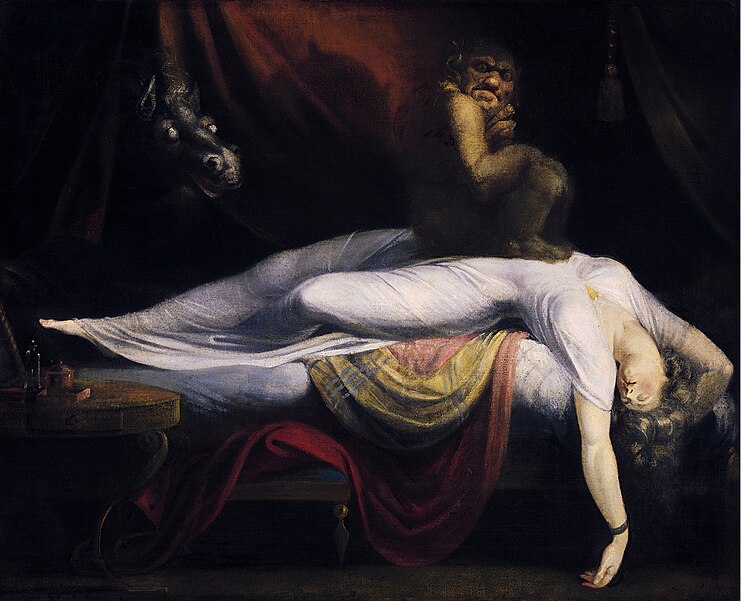My friend from An Undomesticated Blogspot has posted a very good article on sleep paralysis. Its something which many of us have gone through. Read through, and my dua sen prognosis is at the end:
Sleep paralysis sounds unbelievable but it is a very real but rare, experience. You wake from sleep. As you lie in bed, you feel like someone is standing over you in the darkness. You try to move your head only slightly to look, but you can't. Someone - something - is holding you down. You attempt to struggle, to thrash your arms and legs, but you are frozen in place. Sheer panic washes over you as your paralysis lingers.
The original definition of sleep paralysis was codified by Dr. Samuel Johnson in his A Dictionary of the English Language as “nightmare.” Such sleep paralysis was widely considered to be the work of demons, more specifically incubi, which were thought to sit on the chests of sleepers. In Old English the name for these beings was mare or mære.
In Swedish folklore, sleep paralysis is caused by a Mare, a supernatural creature related to the werewolf. The Mare is a damned woman, who is cursed and her body is carried mysteriously during sleep and without her noticing. In this state, she visits villagers to sit on their rib cages while they are asleep, causing them to experience nightmares. An upcoming Swedish film, Marianne (2011 film), examines the folklore surrounding sleep paralysis.
Folklore in Newfoundland, South Carolina and Georgia describe the negative figure of the Hag who leaves her physical body at night, and sits on the chest of her victim. The victim usually wakes with a feeling of terror, has difficulty breathing because of a perceived heavy invisible weight on his or her chest, and is unable to move.
In Fiji the experience is interpreted as “kana tevoro” being ‘eaten’ or possessed by a demon. It is believed the spirit can be a recently dead relative who has come back for some unfinished business, or has come to communicate some important news to the living.
In some African communities, sleep paralysis is referred as “the Devil on your back. In Turkey and in many of islamic beliefs, sleep paralysis is called “Karabasan” which is very similar to the classic story of a demon visiting a person in sleep, most commonly called a Djinn.
 |
| The Nightmare by Henry Fuseli (1781) is thought to be one of the classic depictions of sleep paralysis perceived as a demonic visitation. |
What is sleep paralysis?
Sleep paralysis consists of a period of inability to perform voluntary movements either at sleep onset (called hypnogogic or predormital form) or upon awakening (called hypnopompic or postdormtal form).
Sleep paralysis is most often associated with narcolepsy, a neurological condition in which the person has uncontrollable naps. However, there are many people who experience sleep paralysis without having signs of narcolepsy. Sometimes it runs in families. There is no known explanation why some people experience this paralysis. It is not harmful, although most people report feeling very afraid because they do not know what is happening, and within minutes they gradually or abruptly are able to move again; the episode is often terminated by a sound or a touch on the body.
In some cases, people feel that someone is in the room with them, some experience the feeling that someone or something is sitting on their chest and they feel impending death and suffocation. That has been called the “Hag Phenomena” and has been happening to people over the centuries. These things cause people much anxiety and terror, but there is no physical harm.
What are the symptoms?A complaint of inability to move the trunk or limbs at sleep onset or upon awakening
How can sleep paralysis be stopped or prevented?
You may be able to minimize the episodes by following good sleep hygiene:
- getting enough sleep
- reduce stress
- exercise regularly (but not too close to bedtime)
- keep a regular sleep schedule
why: usually when we are tired, or more tired than usual, or when we have over-exerted our mental faculties
how: its like your whole body went to sleep but your mind is still awake, but your mind is unable to tell your body otherwise ...
the stories: imagine your mind is bright n cheery n the rest of yr body is asleep (hence not following motor instructions to move your body parts) ... you can try your hardest and not one muscle will move, knowing our minds, it will try to come up with one hundred and one possibilities... hence the ghosts tradition ... when u dream anything is possible, and when u cannot move yr body yr mind will come up with the harshest possibilities
cure: just close yr eyes, relax, go back to sleep










